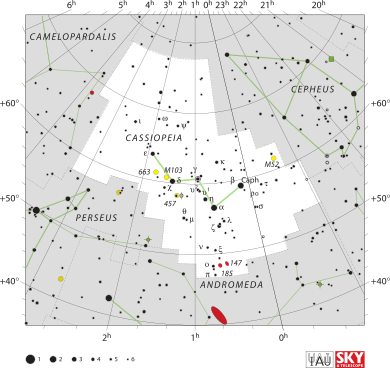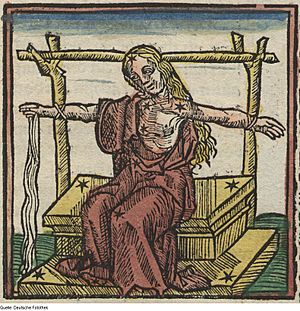Cassiopeia (constellation) facts for kids
| Constellation | |

List of stars in Cassiopeia
|
|
| Abbreviation | Cas |
|---|---|
| Genitive | Cassiopeiae |
| Pronunciation | Cássiopéia, esp. for the constellation also Cássiópeia; genitive |
| Symbolism | the Seated Queen |
| Right ascension | 22h 57m 04.5897s–03h 41m 14.0997s |
| Declination | 77.6923447°–48.6632690° |
| Area | 598 sq. deg. (25th) |
| Main stars | 5 |
| Bayer/Flamsteed stars |
53 |
| Stars with planets | 14 |
| Stars brighter than 3.00m | 4 |
| Stars within 10.00 pc (32.62 ly) | 7 |
| Brightest star | α Cas (Schedar) (2.24m) |
| Messier objects | 2 |
| Meteor showers | Perseids |
| Bordering constellations |
Camelopardalis Cepheus Lacerta Andromeda Perseus |
| Visible at latitudes between +90° and −20°. Best visible at 21:00 (9 p.m.) during the month of November. |
|
Cassiopeia is a well-known constellation in the northern sky. It is named after a queen from Greek mythology who was very proud of her beauty. Cassiopeia was one of the first 48 constellations listed by an ancient Greek astronomer named Ptolemy. Today, it is still one of the 88 modern constellations we recognize.
You can easily spot Cassiopeia because its five brightest stars form a clear 'W' shape. It is located opposite the Big Dipper in the sky. If you live in northern places, like Canada or the northern United States, you can see Cassiopeia all year round. In warmer areas closer to the equator, it is best seen from September to early November. Even in some southern countries, you can see it low in the northern sky.
The brightest star in Cassiopeia is usually Alpha Cassiopeiae, also called Schedar. It shines at a brightness of 2.2. However, another star, Gamma Cassiopeiae, can sometimes become even brighter. Cassiopeia also has some of the brightest stars known, including huge yellow and white stars. One star, PZ Cassiopeiae, is among the largest stars ever found!
In 1572, a very bright supernova (an exploding star) appeared in Cassiopeia. This event was studied by the famous astronomer Tycho Brahe. Another interesting object is Cassiopeia A, which is what's left after a star exploded. It is the brightest natural radio source in the sky. Scientists have also found 14 star systems in Cassiopeia that have planets orbiting them. One of these systems, HR 8832, might even have seven planets!
A part of the Milky Way galaxy passes through Cassiopeia. This means you can find many interesting things there. These include groups of young stars called open clusters and clouds of gas and dust called nebulae. IC 10 is a special type of galaxy called a starburst galaxy. It is the closest one to us and the only one in our group of galaxies.
Contents
Mythology of Cassiopeia
The constellation Cassiopeia is named after a queen from ancient Greek stories. She was the queen of Aethiopia, married to King Cepheus, and mother to Princess Andromeda.
Cassiopeia was very proud of her beauty. She boasted that she was even more beautiful than the Nereids, who were sea nymphs. This made the sea god Poseidon very angry. As a punishment, Poseidon placed Cassiopeia in the sky on her throne. She has to spin around the North Celestial Pole, sometimes hanging upside down so she doesn't fall off.
Poseidon also demanded that Andromeda, Cassiopeia's daughter, be tied to a rock as food for a sea monster named Cetus. Luckily, the hero Perseus rescued Andromeda. Later, Perseus and Andromeda got married. In the sky, Cassiopeia is placed near her husband Cepheus and her daughter Andromeda.
What Makes Cassiopeia Special?
Cassiopeia covers a large area of the sky, about 598 square degrees. This makes it the 25th largest constellation out of 88. It is next to other constellations like Cepheus, Andromeda, Perseus, Camelopardalis, and Lacerta.
The short name for Cassiopeia, used by astronomers, is 'Cas'. This was decided by the International Astronomical Union in 1922. The official borders of the constellation were set in 1930.
Because Cassiopeia is in the Northern Celestial Hemisphere, people living north of 12°S latitude can see the entire constellation. If you live in places like the British Isles, Canada, or the northern United States, Cassiopeia is a circumpolar constellation. This means it never sets below the horizon and is visible in the night sky all year long.
Stars of Cassiopeia
Astronomers have given names to the brightest stars in Cassiopeia using Greek letters. There are 157 stars in Cassiopeia that are bright enough to be seen with a good telescope.
The 'W' Shape of Cassiopeia
The most famous part of Cassiopeia is its 'W' shape. This shape is made by five bright stars: Alpha, Beta, Gamma, Delta, and Epsilon Cassiopeiae. You can easily see all five of these stars without a telescope. Three of them change in brightness, and one might also change a little.
When Cassiopeia is below the North Star (Polaris) during spring and summer nights in the northern hemisphere, it looks like a 'W'. In the northern winter, or when seen from southern places, it appears upside down, like an 'M'.
- Alpha Cassiopeiae, also called Schedar, is a giant orange star. It is about 228 light-years away from Earth. It is much bigger and brighter than our Sun. Schedar is actually a multiple star system, meaning it has more than one star.
- Beta Cassiopeiae, or Caph, is a white star about 54.7 light-years from Earth. It is about 1.9 times as massive as the Sun. Caph spins very fast, completing a full turn in just over a day. This fast spin makes it slightly flattened at its poles. It also changes its brightness a tiny bit over about 2.5 hours.
- Gamma Cassiopeiae is a special type of variable star. It can change its brightness a lot, from 1.6 to 3.0, but usually stays around 2.2. These changes are unpredictable. Gamma Cassiopeiae is also a spectroscopic binary, which means it has a companion star orbiting it, though we can't see it directly.
- Delta Cassiopeiae, also known as Ruchbah, is an eclipsing binary star. This means it is two stars that orbit each other, and one star passes in front of the other, causing the total brightness to change. Its brightness changes slightly over a period of about 2 years and 1 month. It is about 99.4 light-years away.
- Epsilon Cassiopeiae is a hot, blue-white star about 410 light-years from Earth. It is much larger and more massive than the Sun. Epsilon Cassiopeiae is a Be star, which means it spins very fast and throws off a ring of material around itself.
Meteor Shower
The December Phi Cassiopeiids is a meteor shower that happens in early December. The meteors appear to come from the direction of Cassiopeia. These meteors are quite slow, entering Earth's atmosphere at about 16.7 kilometers per second. Scientists believe they come from a comet, but they don't know exactly which one.
Cassiopeia in Pop Culture
Cassiopeia has appeared in many books, movies, and songs:
- In J.R.R. Tolkien's fantasy world, Cassiopeia is called Wilwarin, which means "the butterfly" in Elvish.
- In the 1854 science fiction novel Star, the author wrote about tall, blue-haired humans living on a planet around the star Psi Cassiopeia.
- A character in the original Battlestar Galactica TV show was named Cassiopeia.
- In the 1997 movie Contact, the main character, Dr. Eleanor Arroway, talks about listening to radio signals from Cassiopeia A, which is a supernova remnant.
- In an episode of The X-Files called "Patient X", a character's fingerprints match the pattern of the Cassiopeia constellation.
- In the 2001 film Serendipity, a character points out that the freckles on another character's arm look exactly like the Cassiopeia constellation.
- In the movie The Edge, a character uses Cassiopeia to find the North Star.
- The musical In the Heights mentions that you can't see Cassiopeia in New York City because of the bright city lights.
- Singer Sara Bareilles has a song called "Cassiopeia" on her 2013 album. She imagined the constellation as a person falling in love with another star.
- In The Fifth Wave book series, the main character is named Cassie, short for Cassiopeia.
- In Japan's first super sentai series, Himitsu Sentai Gorenger, cosmic rays from Cassiopeia are important for defeating the main enemy.
Images for kids
-
Kappa Cassiopeiae and its bow shock. Spitzer infrared image (NASA/JPL-Caltech)
-
The Sun would appear close to Cassiopeia from Alpha Centauri
-
Sky image centered in Cassiopeia taken from a dark site. Some deep sky objects are visible, including the Andromeda Galaxy.
-
Cassiopeia with indication of χ Persei (NGC 884) and h Persei (NGC 869) as well as the star clusters NGC 654, NGC 663, NGC 581 (Messier 103), NGC 457, NGC 225, NGC 7788, NGC 7790, NGC 7789 and NGC 7654 (Messier 52).
See also
 In Spanish: Casiopea (constelación) para niños
In Spanish: Casiopea (constelación) para niños









